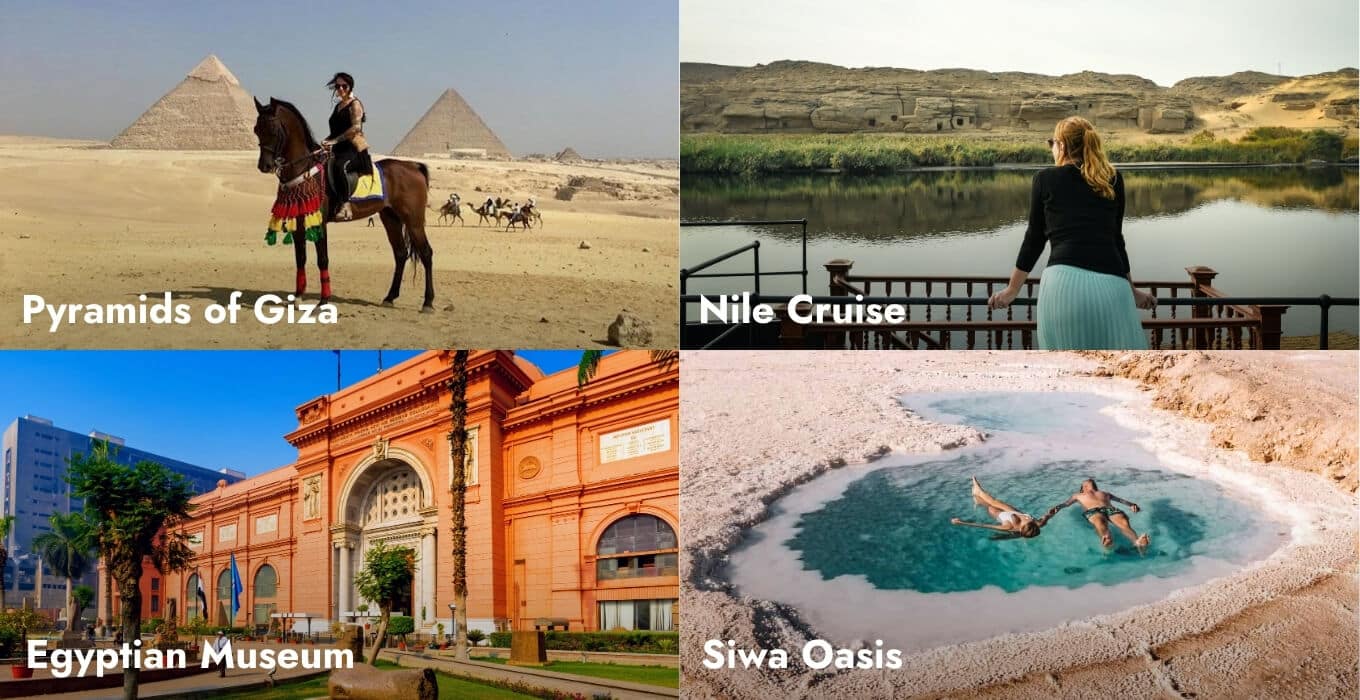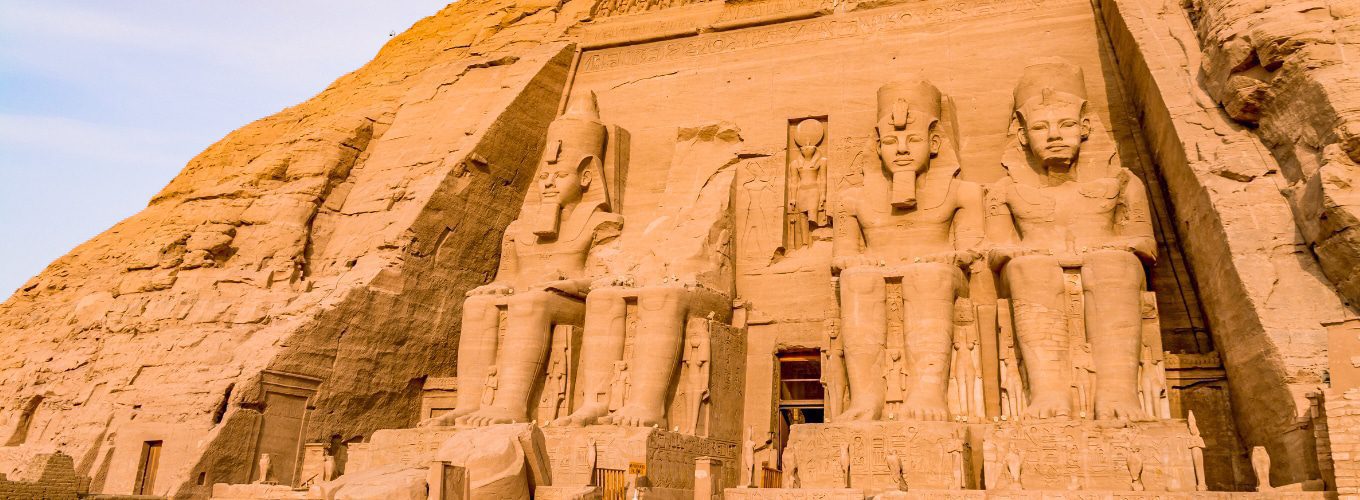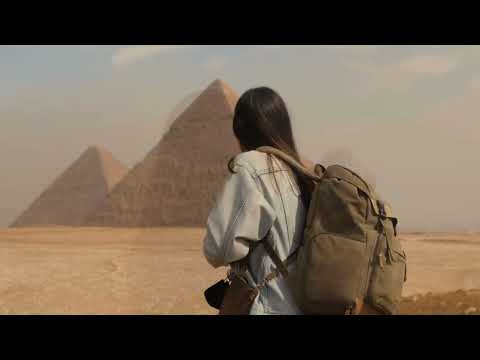Egypt is a top destination, known for the oldest man-made structure, the Pyramids of Giza. It has many ancient wonders and a lively culture to explore. This guide from Egypt Planners will help you make the best Egypt itinerary, for 5 days or 2 weeks.
See the ancient sights of Cairo, sail the Nile, find Luxor’s treasures, and relax at the Red Sea. Our itineraries and tips will help plan your dream Egypt vacation. You’ll experience Egypt’s timeless beauty.
Are you ready to explore this ancient land and make an Egypt travel itinerary that will amaze you? Let’s start and find the perfect adventure for you!
Key Takeaways
- Discover the ancient wonders of Egypt, from the Pyramids of Giza to the temples of Luxor
- Customize your Egypt itinerary to fit your travel style and budget
- Explore the vibrant culture and rich history of this timeless destination
- Enjoy the stunning natural beauty of the Nile River and the Red Sea Riviera
- Uncover hidden gems and off-the-beaten-path destinations for an authentic experience
Unveiling the Ancient Wonders of Egypt in Egypt trip itinerary
Egypt is a land filled with thousands of years of ancient Egyptian history. It’s home to some of the most famous ancient Egyptian monuments in the world. The Pyramids of Giza and the big temples of Luxor are just the start. This place takes you back to the time of the ancient pharaohs.
See the Valley of the Kings and the huge statues of Ramses II. Discover the secrets of the ancient Egyptian civilization. Egypt’s ancient Egyptian monuments and egyptian antiquities will amaze you. They show the beauty of its Egyptian culture.
“Egypt is not a country we live in, but a country that lives within us.” – Naguib Mahfouz, Nobel Laureate in Literature
Egypt has Egyptian museums full of priceless artifacts and amazing sites. Its ancient wonders give you a deep and memorable experience. Get ready to go back in time and see why this place has been a ancient wonder for so long.
Crafting Your egypt trip itinerary
Creating the perfect Egypt itinerary means knowing what you like. Do you want a quick trip to see the main sights or a slow pace to soak in the culture and history? Egypt Planners can guide you. They’ll help pick the best itinerary length and places for your time, whether it’s 5 days, 7 days, or 10 days. We’ll also share tips on finding great places to stay and making the most of your time at famous spots.
Determining Your Travel Style
How long you stay in Egypt changes what you can do and see. With little time, a 5-day or 7-day itinerary covers Cairo, Aswan, and Luxor. But with more time, a 10-day or 14-day itinerary lets you go deeper into Egypt’s history and culture. You can visit places like the Siwa Oasis or the Red Sea resorts. Egypt Planners will help pick the right itinerary length for you, making sure you enjoy your trip.
Choosing the Duration of Your Stay
No matter if you have 5 days, 7 days, or 10 days in Egypt, Egypt Planners can make the ideal itinerary for you. We offer many itinerary choices, from quick adventures to slow cultural experiences. We make sure your Egypt trip fits your style and leaves you with great memories.
Cairo: Gateway to Egypt’s Grandeur
No trip to Egypt is complete without seeing the Pyramids of Giza and the Sphinx. The Giza Pyramids are the last Wonder of the Ancient World still standing. They are a sight that will amaze you. You’ll also see the Sphinx, a creature with a human head and a lion’s body.
The Giza Plateau is a key part of any Egypt trip. Egypt Planners can help plan your visit. They offer tips on avoiding crowds and getting the best photos.
The Egyptian Museum
The Egyptian Museum in Cairo is full of ancient Egyptian artifacts. It has the world’s biggest collection of Pharaonic antiquities. You’ll see the famous golden mask of Tutankhamun and many other relics.
The museum shows the history and culture of ancient Egypt. From everyday items to royal treasures, it’s all here. Egypt Planners can guide you through the museum. They make sure you see the best parts.
Khan El-Khalili Bazaar
Experience the lively Cairo’s Khan El-Khalili Bazaar, a market that’s been busy for centuries. You can walk through the narrow streets, talk prices with sellers, and find traditional crafts and spices. It’s also a place to try Egyptian cuisine at many food spots.
Egypt Planners have tips for the bazaar. They help you enjoy this famous Cairo spot.
Aswan: A Nubian Oasis on the Nile

Situated on the banks of the Nile River, Aswan is a serene and picturesque city. It offers a glimpse into the rich Nubian culture of Egypt. The city has mild winters and hot summers, with temperatures up to 50°C.
Explore the captivating Philae Temple, a stunning complex dedicated to the goddess Isis. Visit the Unfinished Obelisk, an ancient monument that shows the engineering skills of the Pharaohs. Enjoy a relaxing felucca ride along the Nile River, soaking in the peaceful vibe of this Nubian oasis.
The Nubian Museum in Aswan has over 5,000 artifacts. It’s a great chance to learn about the history and traditions of the Nubian people. These locals have their own culture, different from the rest of Egypt.
The Aswan Bazaar is full of Nubian crafts like skullcaps, scarves, and jewelry. It’s a place to meet friendly locals and experience the real Nubian culture.
Getting to Aswan is easy by plane or train. It offers an unforgettable journey into Egypt’s Nubian culture. Use Egypt Planners to plan your trip and see the beauty of this city by the Nile River.
The Nile River Cruise Experience
Start a magical journey through Egypt’s heart with a Nile river cruise. You’ll sail the legendary Nile, seeing ancient wonders up close. From your floating hotel, visit sites like Kom Ombo, Edfu, and the Valley of the Kings.
This cruise is perfect for those wanting to see Egypt in a unique way. It lasts from 3 to 7 nights, or even up to two weeks. The best time to go is from October to April, when the weather is nice.
Enjoy delicious local food, beautiful views, and easy travel on your cruise. Expert guides will take you on exciting tours. You’ll learn a lot about Egypt’s history and culture.
| Nile Cruise Itinerary | Duration | Approximate Cost |
| 3-night Nile Cruise | 3 nights | $450-$650 per person |
| 4-night Nile Cruise | 4 nights | $550-$750 per person |
| 7-night Nile Cruise | 7 nights | $780-$1,100 per person |
| Long Nile Cruise | Up to 14 nights | $1,500-$2,500 per person |
Cruising the Nile is a key way to see Egypt’s beauty and history. Whether you choose a 3-night or 7-night cruise, you’ll make unforgettable memories. You’ll learn to love this amazing place.
Egypt Itinerary: Luxor, the Jewel of the Nile
Luxor is a key stop on any Egypt trip, known as the “Jewel of the Nile.” See the huge Karnak Temple, a top religious spot. Then, head to the Valley of the Kings to see Pharaohs’ tombs.
Don’t miss the Luxor Temple, a place of old festivals. You can see it on foot, by hot air balloon, or on a Nile cruise. This city will amaze you with its ancient history.
Try Tauck’s “Egypt: Jewels of the Nile” tour for a deep dive into Luxor. It’s a 4-night cruise on the River Nile on the Oberoi Philae or Oberoi Zahra. With 24 guests, you’ll enjoy Luxor’s history and landmarks at your pace.
| Luxor Attractions | Entrance Fees (EGP) |
| Karnak Temple | 450 |
| Luxor Temple | 400 |
| Valley Of The Kings | 600 |
| Queen Hatshepsut Temple | 360 |
The tour also covers other ancient sites like the Philae Temple, Edfu Temple, and the Giza Pyramids. It lasts 9 days and has 12-42 people. It’s ideal for those wanting to deeply explore Egypt’s history and culture.
“Luxor is a true gem, a city that transports you back in time to the glory of ancient Egypt. From the towering Karnak Temple to the Valley of the Kings, every moment spent in Luxor is a testament to the enduring legacy of this remarkable civilization.”
Visiting Luxor, whether on a Nile River cruise or alone, is a must. It will make a big impact on your Egypt trip.
Red Sea Resorts: Relaxation and Underwater Marvels
After exploring Egypt’s history and culture, relax at the beautiful red sea resorts on the eastern coast. El Gouna, called the “Venice of Egypt,” is perfect for both relaxation and adventure. Enjoy top-notch red sea diving, see the colorful underwater life, or just relax on the clean Egyptian beach resorts. The Red Sea Riviera has many luxury places to stay, making it great for a beach vacation. Egypt Planners can help plan your Red Sea resort trip to end your Egypt journey.
El Gouna and the Red Sea Riviera
El Gouna, by the Red Sea, is a beautiful place. It has clear waters, white sand beaches, and unique buildings. It’s perfect for those who want to relax or have fun. You can check out the lively marina, try water sports, or just relax at a luxury resort by the Red Sea Riviera.
- Discover the underwater wonders of the Red Sea with amazing Red Sea diving and snorkeling
- Enjoy the friendly people and many food choices in El Gouna’s town centre
- Treat yourself at the famous spas and wellness centres
- Go on exciting trips, like desert safaris or kitesurfing.
The Red Sea resorts and the Red Sea Riviera in Egypt are great for a relaxing or adventurous vacation. They offer the best of sun, sand, and beautiful nature.
Off-the-Beaten-Path Gems
Travelers looking for a unique experience in Egypt should visit the Siwa Oasis. It’s a hidden oasis in the Western Desert. Here, you’ll find dunes and salt lakes. It’s a peek into Egypt’s traditional side.
See ancient rocks, ruins, and the Berber culture. This culture has lived in the desert for centuries. Egypt Planners can help plan your trip to Siwa Oasis for an unforgettable adventure.
Siwa Oasis
For a special experience in Egypt, visit the Siwa Oasis. Egypt Planners can show you hidden spots off the tourist path. This journey will reveal the true heart of Egypt.
Islamic Cairo
There’s more to Cairo than the Pyramids and Khan El-Khalili Bazaar. Cairo has Islamic Cairo, a UNESCO site that shows its Islamic heritage. Walk through alleys to see mosques, madrasas, and architecture that tell stories of the past.
Don’t miss the Citadel of Saladin, Mosque of Muhammad Ali, and Al-Azhar Mosque. They show the beauty and traditions of Islamic Cairo. Egypt Planners can guide you through this hidden gem.
Egypt Travel Tips
Traveling to Egypt is an amazing adventure. But, you need to be ready. Egypt Planners has tips to help you enjoy your trip. We cover visa and currency needs, customs, and how to get around.
Visas and Entry Requirements
You’ll likely need a visa to visit Egypt. You can get it before you go or when you arrive at the airport. Make sure your passport is valid for six months after your trip.
Currency and Spending
The Egyptian Pound (EGP) is Egypt’s money. Bring cash and cards, as some places only take cash in small towns. Watch out for exchange rates and fees when using ATMs or exchanging money.
Transportation
- Egypt has buses, trains, and taxis for getting around. The subway in Cairo is a good choice for city travel.
- Domestic flights are quick for visiting places like the Pyramids or Luxor’s temples.
- Nile River cruises are a great way to see Egypt’s sites at a relaxed pace.
Tipping and Etiquette
Tipping is big in Egypt. You should tip at restaurants, with tour guides, and hotel staff. Always tip in cash. Also, dress modestly, especially at religious places.
Learn these Egypt travel tips to explore with confidence. You’ll make memories that last forever.
Best Egypt Tour Packages

Explore Egypt’s wonders with our Egypt tour packages. Choose from a 5-day Cairo and Pyramids trip or a 10-day Nile River cruise. Our travel experts have the perfect plan for you, no matter your budget.
Our Egypt travel packages start at just $464 for a 4-day trip. Prices go up to $1,903 for luxury. We have Egypt vacation packages from $499 for all types of travelers.
The best time to visit is from September to April. This is when it’s cool, with temperatures from 9.5°C to 32°C. You’ll see top spots like Cairo, Luxor, Aswan, and Alexandria. Our packages last from 5 to 9 days.
Join us for an all-inclusive tour of Egypt’s history, culture, and beauty. We take care of everything, making your trip smooth and memorable.
Explore Our Top Egypt Tour Packages
- 7-Day Cairo with Nile Cruise Tour Package Get -100 USD
- 8 Days Cairo with 3 Nights Nile Cruise by Flight Get 10% Off + Free Activities
- 8 Days Cairo and Nile Cruise Holidays with Abu Simbel Get 7% OFF
- 10-Day Cairo, Alexandria, and Nile Cruise with Abu Simbel by Flight Get 10% OFF
With our expert team, your Egypt tour packages will be amazing. Start planning your Egypt trip today!
Conclusion
Egypt is a place full of ancient wonders, vibrant culture, and stunning beauty. It’s home to the famous Pyramids of Giza and the peaceful Nile River. This country is a top spot for anyone looking to travel to Egypt.
With the help of Egypt Planners, you can plan the perfect trip. They offer expert advice and special tour packages. Whether you have a week or two, you’ll get to see Egypt’s best spots.
Start planning your trip now. Discover the magic of Egypt and make memories that will last forever.
Egypt has a rich history, beautiful landscapes, and a lively culture. A good plan lets you see all the top sights. You’ll visit Cairo’s ancient wonders and see the beauty of Aswan and Luxor.
So, what are you waiting for? Begin planning your Egypt dream trip today. Get ready for an amazing journey through a place full of history and beauty. Egypt Planners can help you make a trip that fits your interests and travel style. It will be an unforgettable adventure in this magical land.
Don’t forget to check out our related article:


